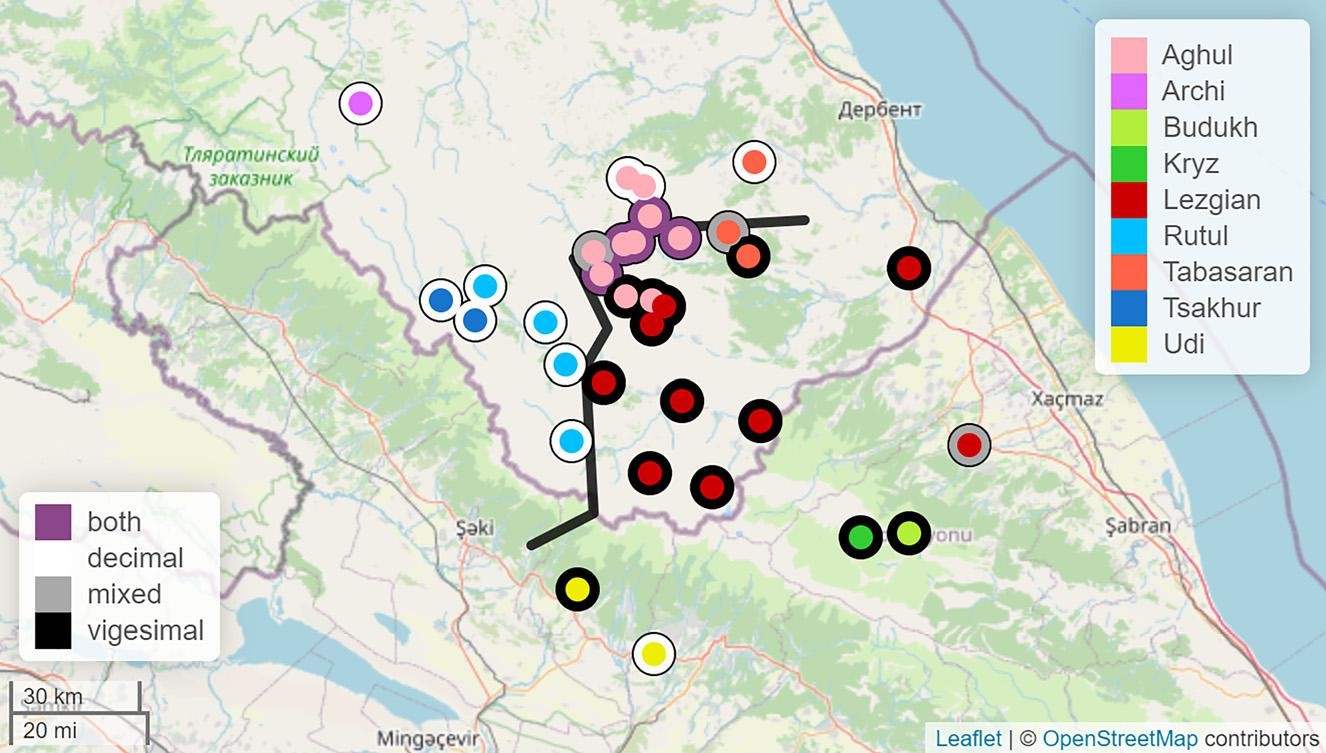Twenty vs Ten: HSE Researcher Examines Origins of Numeral System in Lezgic Languages

It is commonly believed that the Lezgic languages spoken in Dagestan and Azerbaijan originally used a vigesimal numeral system, with the decimal system emerging later. However, a recent analysis of numerals in various dialects, conducted by linguist Maksim Melenchenko from HSE University, suggests that the opposite may be true: the decimal system was used originally, with the vigesimal system developing later. The study has been published in Folia Linguistica.
How many fingers do you need to count to forty? That depends on the language you are counting in. In Russian and most European languages, the decimal counting system is standard, with numbers like 40 formed as 4 × 10, 60 as 6 × 10, and so on. A vigesimal system is based on the number 20, so 60 is expressed as 3 × 20, and 50 as 2 × 20 + 10.
Counting by tens or twenties is not just a matter of convenience—it also has historical roots. In the Lezgic group of languages—which includes Lezgian, Tabasaran, Aghul, and Rutul—both numeral systems are found: some dialects use a base-10 system with numbers like 10, 20, 30, while others follow a base-20 system with numbers like 20, 40, 60, and so on. Until recently, it was believed that the vigesimal system in these languages was more ancient, but a new study by linguists at HSE University challenges this assumption.
Maksim Melenchenko, Research Assistant at the Linguistic Convergence Laboratory of the HSE Faculty of Humanities, analysed numerals in nine Lezgic languages and concluded that the decimal system may have existed earlier, rather than being a later borrowing. In some languages, he discovered supposedly archaic forms of the number 40, suggesting an alternative development of the counting system. These forms are called archaic because certain features make them appear older than modern numerals.

Maksim Melenchenko
'For the number 40, some Lezgic languages unexpectedly use a decimal system: even in villages where counting by twenties is common, 40 is expressed as 4 × 10. This may indicate that the overall system of numeral formation has changed, but earlier forms of the number forty have persisted in the language, reflecting an older numeral system,' explains Melenchenko.
Another detail noted by the linguist is the special suffixes found on all decimal numerals from 30 to 90. In some languages where these numbers are formed decimally, they end with a suffix that originally indicated the grammatical gender of the noun the numeral refers to.
'This suggests that, in earlier times, the suffixes of decimal numerals actually changed to reflect grammatical gender. This implies that the decimal system was not a later introduction but had been in use long enough for gender markers in decimal numerals to become fossilised,' the linguist notes.
Dialectal variations in numeral systems can sometimes occur on opposite sides of the same mountain. For example, in the northern areas where Aghul is spoken, people count by tens, while in the southern parts, they count by twenties. Sometimes both systems coexist side by side: the older generation sticks to the traditional system, younger people use the more recent one, and some numerals reflect a mix of both systems.

Such variability shows how vibrant and dynamic different elements of a language—including numerals—can be. The study suggests that numeral systems can be easily borrowed, adapted, and changed spontaneously. Their history is not simply a progression from 'primitive' to 'advanced' structures, but a complex process that deserves close study—especially in linguistically rich and diverse regions like the Caucasus.
The study was conducted with support from HSE University's Basic Research Programme within the framework of the Centres of Excellence project.
See also:
HSE Psycholinguists Launch Digital Tool to Spot Dyslexia in Children
Specialists from HSE University's Centre for Language and Brain have introduced LexiMetr, a new digital tool for diagnosing dyslexia in primary school students. This is the first standardised application in Russia that enables fast and reliable assessment of children’s reading skills to identify dyslexia or the risk of developing it. The application is available on the RuStore platform and runs on Android tablets.
HSE Scientists Optimise Training of Generative Flow Networks
Researchers at the HSE Faculty of Computer Science have optimised the training method for generative flow neural networks to handle unstructured tasks, which could make the search for new drugs more efficient. The results of their work were presented at ICLR 2025, one of the world’s leading conferences on machine learning. The paper is available at Arxiv.org.
Physicists Propose New Mechanism to Enhance Superconductivity with 'Quantum Glue'
A team of researchers, including scientists from HSE MIEM, has demonstrated that defects in a material can enhance, rather than hinder, superconductivity. This occurs through interaction between defective and cleaner regions, which creates a 'quantum glue'—a uniform component that binds distinct superconducting regions into a single network. Calculations confirm that this mechanism could aid in developing superconductors that operate at higher temperatures. The study has been published in Communications Physics.
Neural Network Trained to Predict Crises in Russian Stock Market
Economists from HSE University have developed a neural network model that can predict the onset of a short-term stock market crisis with over 83% accuracy, one day in advance. The model performs well even on complex, imbalanced data and incorporates not only economic indicators but also investor sentiment. The paper by Tamara Teplova, Maksim Fayzulin, and Aleksei Kurkin from the Centre for Financial Research and Data Analytics at the HSE Faculty of Economic Sciences has been published in Socio-Economic Planning Sciences.
Larger Groups of Students Use AI More Effectively in Learning
Researchers at the Institute of Education and the Faculty of Economic Sciences at HSE University have studied what factors determine the success of student group projects when they are completed with the help of artificial intelligence (AI). Their findings suggest that, in addition to the knowledge level of the team members, the size of the group also plays a significant role—the larger it is, the more efficient the process becomes. The study was published in Innovations in Education and Teaching International.
New Models for Studying Diseases: From Petri Dishes to Organs-on-a-Chip
Biologists from HSE University, in collaboration with researchers from the Kulakov National Medical Research Centre for Obstetrics, Gynecology, and Perinatology, have used advanced microfluidic technologies to study preeclampsia—one of the most dangerous pregnancy complications, posing serious risks to the life and health of both mother and child. In a paper published in BioChip Journal, the researchers review modern cellular models—including advanced placenta-on-a-chip technologies—that offer deeper insights into the mechanisms of the disorder and support the development of effective treatments.
Using Two Cryptocurrencies Enhances Volatility Forecasting
Researchers from the HSE Faculty of Economic Sciences have found that Bitcoin price volatility can be effectively predicted using Ethereum, the second-most popular cryptocurrency. Incorporating Ethereum into a predictive model reduces the forecast error to 23%, outperforming neural networks and other complex algorithms. The article has been published in Applied Econometrics.
Administrative Staff Are Crucial to University Efficiency—But Only in Teaching-Oriented Institutions
An international team of researchers, including scholars from HSE University, has analysed how the number of non-academic staff affects a university’s performance. The study found that the outcome depends on the institution’s profile: in research universities, the share of administrative and support staff has no effect on efficiency, whereas in teaching-oriented universities, there is a positive correlation. The findings have been published in Applied Economics.
Advancing Personalised Therapy for More Effective Cancer Treatment
Researchers from the International Laboratory of Microphysiological Systems at HSE University's Faculty of Biology and Biotechnology are developing methods to reduce tumour cell resistance to drugs and to create more effective, personalised cancer treatments. In this interview with the HSE News Service, Diana Maltseva, Head of the Laboratory, talks about their work.
Physicists at HSE University Reveal How Vortices Behave in Two-Dimensional Turbulence
Researchers from the Landau Institute for Theoretical Physics of the Russian Academy of Sciences and the HSE University's Faculty of Physics have discovered how external forces affect the behaviour of turbulent flows. The scientists showed that even a small external torque can stabilise the system and extend the lifetime of large vortices. These findings may improve the accuracy of models of atmospheric and oceanic circulation. The paper has been published in Physics of Fluids.


